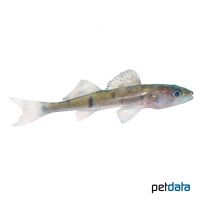Pikeperch (Sander lucioperca)
| Pikeperch Sander lucioperca | |
|---|---|
| Name | Pikeperch |
| Name Lat. | Sander lucioperca |
| Synonym | Zander |
| Family | Perches |
| Family lat. | Percidae |
| Order | Perch-likes |
| Order lat. | Perciformes |
| Origin | Europe, Asia |
| Habitat | Estuaries, rivers, lakes |
| Diet | Carnivore |
| pH | 7.0-7.5 |
| Behavior | Peaceful |
| Keeping | Individual |
| Care Level | Moderate |
| Reproduction | Substrate spawner |
| Breeding | Moderately difficult |
| Life Span | 15-20 years |
| Protection | No |
| Metric Units | |
| Size | 40-70 cm |
| Temperature | 4-22 °C |
| Hardness | 5-10 °dH |
| Aquarium | Ponds |
| US Units | |
| Size | 16"-28" |
| Temperature | 39-72 °F |
| Hardness | 89-178 ppm |
| Aquarium | Ponds |
Distribution and habitat
The range of the crepuscular and nocturnal pikeperch extends from Europe, north of the Pyrenees and Alps, to the Aral Sea. They live in large rivers and nutrient-rich lakes with turbid water and hard, sandy bottoms, where they hide among rocks and roots in deep water during the day.
Maintenance
A very large pond is recommended, which should be furnished with pond, floating and oxygenating underwater plants (milfoil, waterweed, hornwort, etc.), large river pebbles with numerous, shady hiding places as well as a substrate of round-grained gravel and sand, offering plenty of free swimming space.
No ammonia, ammonium or nitrite should be detectable in the water, and the nitrate value should not exceed 100 mg/l. To ensure water quality and oxygen content, a filter adapted to the water volume is necessary.
Diet
The voracious predators feed mainly on fish up to 10 cm in size, which they hunt in open water. The food supply consists of insect larvae, fish spawn, worms and live fish according to their size. After habituation, high-quality, protein-rich dry food (granules, pellets) is also accepted
Only as much should be fed as is eaten within a few minutes. A regular and varied diet promotes health and increases resistance.
Behaviour and compatibility
The juveniles live in schools, but adults behave intra-species territorial. Only in sufficiently large ponds several animals can be kept together. They can be socialized only with other large and defensible fish, because too small fish are considered prey
In principle, only mutually compatible fish species with similar requirements for water quality and water temperature may be socialized.
Reproduction and breeding
There are no known external distinguishing characteristics of the sexes. At spawning time, the female appears somewhat rounder.
They spawn between April and June at a water temperature of 10-15 °C. The female lays her 1.5 mm sticky eggs between roots and plants in 0.5-3 m water depth. The clutch is intensively guarded by the male until hatching. The young fish feed on animal plankton. In the wild they can live up to 15 years.
Important
Walleye are the largest European perch fish. They can see excellently even in very low light, thanks to a reflective pigment layer in the eye (Tapetum lucidum)
If they are overwintered in the pond, it is necessary to ensure sufficient depth and oxygen supply (filter, oxygen dispenser, ice free holder).
At temperatures below 8-10 °C the metabolism of the fish slows down and food is no longer accepted, feeding must be stopped accordingly. If the temperature drops further, they hibernate near the bottom. In spring, with rising temperatures, feeding can slowly be resumed. Feeding may also be necessary during prolonged warm periods in winter.
The well-being of the fish should be monitored regularly. A regular partial water change, according to the pond size is recommended, even if the pollutant load has not yet reached the upper limit. Sudden changes in water quality should be avoided. Newly introduced fish must be accustomed to the water slowly
Further literature can be found in your pet store.
References
Text: Werner Winter; Image: petdata
Source: BMELV (1998): Tierschutzgutachten - Haltung von Zierfischen (Süßwasser); RIEHL & BAENSCH (2006): Aquarien Atlas Bd. 3, Mergus Verlag; ENGELMANN (2005): Zootierhaltung - Tiere in menschlicher Obhut: Fische, Verlag Harri Deutsch
- Gemäß § 21 Abs. 5 Tierschutzgesetz idgF
